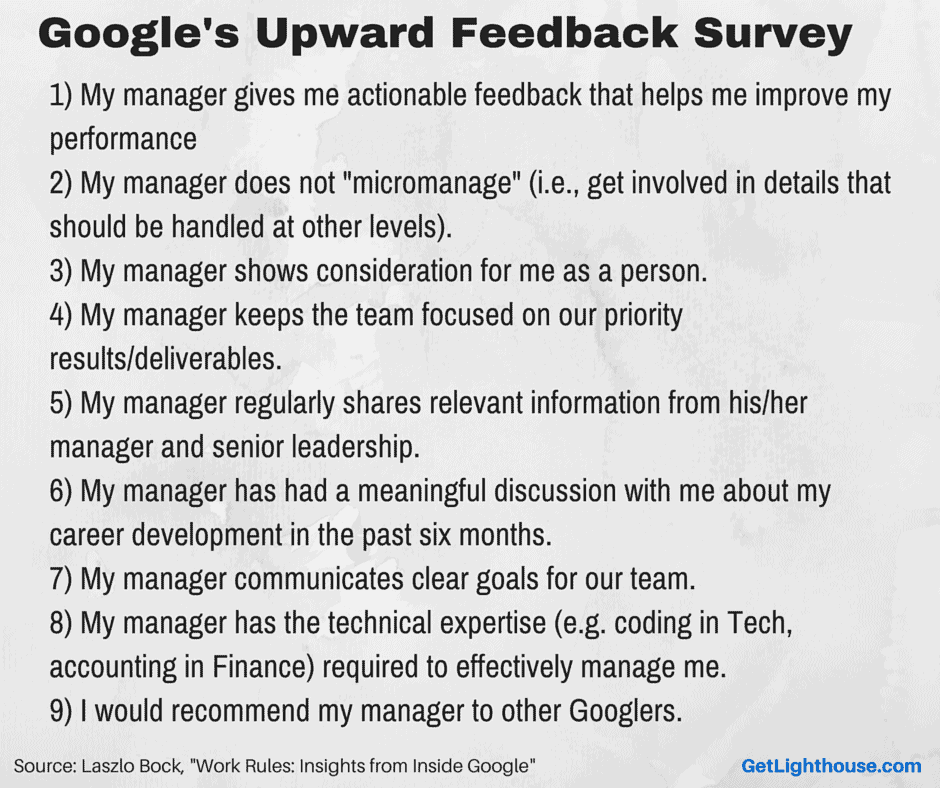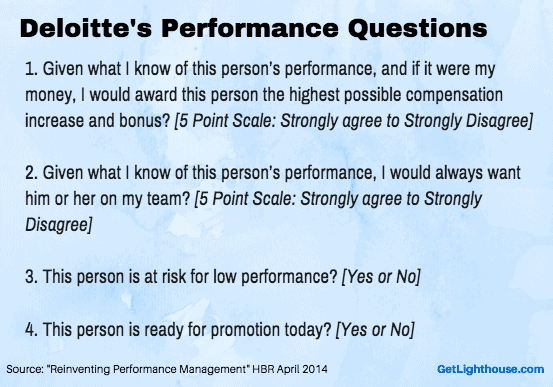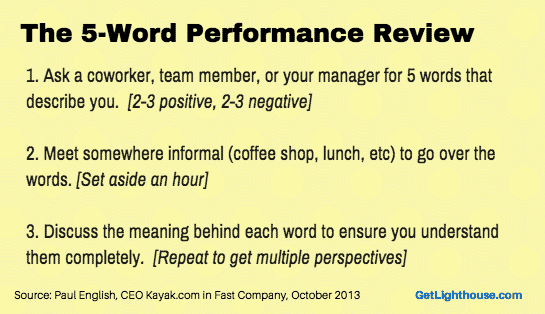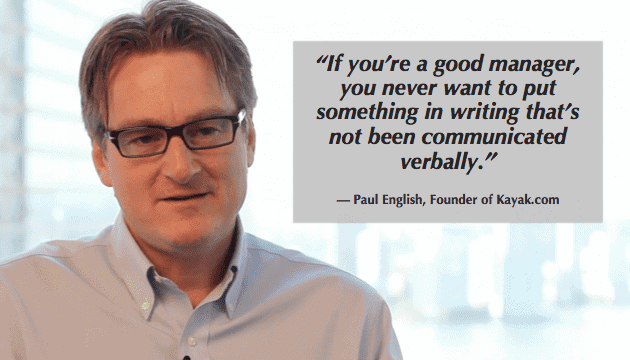With the end of the year fast approaching, many companies will be starting their employee performance review processes. Often, this will mark a moment of dread and discontent, but it doesn't have to be that way.
There are many reasons the employee performance review is not a time that anyone looks forward to. If you're not ready to get rid of the performance review entirely, these approaches can help make them a better experience and give you ideas for tweaking what you're already doing.
5 Ways to Improve the Employee Performance Review
There are no silver bullets in the evaluation of employee performance. These ideas can help you think about ways to make solid, incremental improvements that address some of the biggest problems with reviews today.
1) Get rid of forced stack rankings
Stack ranking became popular in the 1980s thanks to Jack Welch and GE popularizing the "rank and yank" approach. This approach required a certain percentage of every team had to be ranked as exceptional and another percentage had to be ranked poorly and possibly terminated. While this solved the problem of managers marking everyone middle of the road, it created many new problems.
When employees have to compete with the people they work with every day, many problems emerge:
- Your best teams are punished: With forced rankings, a team with many great people can only have some of them rewarded. Some great people will be scored lower than they deserve to fit the rankings. This makes it difficult for a manager to keep everyone engaged after having done their job to "hire the best."
- Competition discourages collaboration: When you're ranked against your colleagues, you're incentivized to fight with them over recognition and work. You can't afford to risk letting someone else get the credit for a big win you worked on, and some may even consider sabotaging their colleagues.
- Politics are more strongly rewarded: When a manager can only rank a few people on their team high, being your boss's favorite becomes much more important than when you are evaluated individually, and on merit for your contributions.
These problems all played out at Microsoft as revealed in an depth article in Vanity Fair:
"By 2002, the by-product of bureaucracy — brutal corporate politics — had reared its head at Microsoft. And, current and former executives said, each year the intensity and destructiveness of the game playing grew worse as employees struggled to beat out their co-workers for promotions, bonuses, or just survival.
Microsoft's managers, intentionally or not, pumped up the volume on the viciousness. What emerged — when combined with the bitterness about financial disparities among employees, the slow pace of development, and the power of the Windows and Office divisions to kill innovation — was a toxic stew of internal antagonism and warfare."
Stack ranking is unpleasant for employees and managers don't enjoy it either. This video from the "Stuff I learned the hard way" Youtube channel captures well why it's painful to stack rank:
With all this mounting evidence and horror stories, it's no surprise that the trend today is to stop using stack ranking employees. If your company is still ranking, take a hard look at whether the damage other companies experience is happening at your company and consider a change if that proves true. You might just be able to take some of the dread out of performance reviews if you do.
2) Ask the right questions
Whether you rank your people or not, the most important decision you make in your evaluations is the questions you ask. What gets measured, gets rewarded or corrected. What doesn't is ignored.
The problem many companies run into is they focus on short term gains:
- Did the sales person hit their number?
- How many leads did marketing create?
- Did their team ship the features they were expected?
Those are important questions, but miss many long term indicators of the health of your business and various teams.
Measure your managers.
Knowing that employees leave managers, not companies, the questions you ask to evaluate your managers are particularly critical.
Managers are multipliers for their people, or they cause the unhappiness that kills good teams. As Eric Weaver, an engineer at ZenDesk shares in his post called "Worst. Managers. Ever," he's seen a pattern in the terrible managers he's had:
"They wanted to "look good." That's the primary thing they cared about, not building an organization, not making their subordinates better, not Doing The Right Thing. No, their primary motivation, I now see in my Retrospect Goggles, was that they wanted to Look Good and Gain Advancement. Any mistake was a mortal offense, rather than a bit of training that needed to happen."
A results-only environment may look fine in the short term, but as employees burn out, leave, or become disengaged, managers that get positive results for the wrong reasons will be exposed. And leaders in an organization will be left with the bill.
Enter Google.
No one has researched their staff and run as many statistically significant experiments on what motivates and drives their employees as Google. And fortunately, they've shared their findings with the world. In their VP of People's book, "Work Rules" they share the key questions they ask to evaluate managers. They are:
Notice how many of these questions play the long game? They're truly telling whether a manager is doing the things that will motivate and retain their employees. Do the questions you ask in evaluating managers do that?
What about evaluating team members?!?
Deloitte recently changed their employee performance review process and now simply ask managers a few simple questions after a major project completes:
What's special about these questions is that they're not the opinion of a manager or colleague; they're about people's actual intentions as it pertains to their job. As Deloitte found in their research, "People may rate other people's skills inconsistently, but they are highly consistent when rating their own feelings and intentions."
The right questions can make all the difference between a biased, unhelpful review, and an accurate, productive one.
3) Separate compensation and performance discussions
One of the common habits of many companies is to include how much of a raise or bonus you will receive as part of a performance review. That turns out to not be good for anyone.
When compensation and performance are combined, it's hard for any feedback to be well-received. Instead, team members often feel like they have to respond to each piece of feedback or risk having it affect their compensation. Performance feedback can also be largely ignored as the team member solely focuses on the dollar amount discussed.
The results in the wild
Lear, a Fortune 500 company, separated the two discussions and saw a dramatic improvement. Suddenly, performance feedback became much better received. As their Chief of Human Resources, Tom DiDanato, reported in Harvard Business Review:
"By taking away concerns about money and status, we've freed employees to relax and hear what their managers have to say, and vice versa."
And they're not alone. Google and Deloitte have similarly separated their discussions and also seen positive impacts.
In the case of Deloitte, they've restructured their processes now as follows:
"We have three interlocking rituals to support them—the annual compensation decision, the quarterly or per-project performance snapshot, and the weekly check-in."
And for those not looking to get rid of their annual employee performance review yet, you can follow Google's suit. They pushed compensation discussions to a month after the performance reviews; annual reviews happen in November, and pay discussions happen in December.
Some of the most data-driven companies in the world have tested and seen great results in separating the two discussions. Consider putting a break in between your performance and compensation discussions and see how it works for you. Just make sure your team member knows you've made the split so they're not expecting both at once.
4) Leverage one on ones before and after
Done well, one on ones are the single best thing you can do to improve performance and motivation on your team. By having an ongoing discussion with your team members, you experience all of these benefits:
- Ongoing, regular feedback: Rather than getting a laundry list of ways to improve at the end of the year, good one on ones can help make adjustments throughout the year, as they happen.
- Fix problems when they're small: If you catch an issue early, it's much easier to correct. This is equally true if something is bothering a team member and could make them quit, as it is fixing a performance issue that could eventually force a termination.
- A full record of the past year: One of the biggest problems in reviews is managers depending on their memory. This leads to annual reviews based on the last few weeks only. If a manager takes notes in one on ones, they'll have a great record of the last year to reflect on.
These all not only improve the performance of your team, but ensure no matter the style of your reviews, you will have helpful things to write and reflect on.
These benefits are why many companies are replacing performance reviews with one on ones. The regular discussions not only supplement a good review, but actually are more effective. Consider these numbers:
- Deloitte was spending close to 2 million employee hours per year on reviews.
- GE found that there was a fivefold productivity increase in the past 12 months for their test group that switched to one on ones.
- Adobe saved almost 80,000 hours of their manager's time on reviews, and saw a 30 percent reduction in voluntary turnover.
What if I want to keep my performance reviews?
You don't have to get rid of performance reviews to experience the benefits of one on ones. In fact, right after reviews is the perfect time to start one on ones! Here's why:
- Pick up where you left off: If you just gave someone a bunch of feedback, ongoing one on ones are the perfect time to continue to talk about improvement in those areas (especially if there's opportunity to praise improvement).
- Ensure career growth: One of the biggest mistakes we see managers make is only talking about career growth at review time. A lack of progress between reviews is a sure-fire way to have your best people seek growth opportunities at new jobs.
- Make progress: A one on one gives you a set time to regularly talk about everything that doesn't fit in your regular work schedule (like items from your performance review). Helping them feel progress on what matters most to them is a powerful source of motivation.
One on ones are a powerful way to make an employee performance review relevant year round. They're also a great habit with a major return on investment for managers to better motivate and engage their teams.
5) Try a 5 word review
If the traditional employee performance review feels too heavyweight, then the 5 word review from Kayak founder Paul English is perfect for you. Here's how it works:
The beauty of this style of review is in its simplicity. By only having 5 words, you move away from lists of specific actions or incidents, and instead focus on the person and what best describes them. It also has other benefits including:
- Memorable: The words are usually adjectives to describe you. That makes it clear what you should do more of or less of over time.
- Actionable: It's hard to always find the takeaway in a multi-paragraph review entry, but if someone says you're "Inconsistent", you know what you need to change.
- Thematic: If you ask multiple people, you're going to hear some consistent words and themes across 5 word reviews. This can really help you with your self-awareness and understanding how others perceive you.
This constraint also forces creativity. With only a few words to choose, they must focus on the handful of most important words to convey to you. That prioritization helps ensure the most important message is heard.
Have a candid conversation
The other major benefit to this method is that you absolutely have to to have a face to face conversation about the words. This helps avoid any misunderstanding and gives you room to have a healthy discussion about the meaning behind each word chosen. If you follow English's advice and make it an informal discussion outside the office, it will also help take some of the tension out of being evaluated.
Of course you don't need HR to do a 5 word review. This can be a great exercise at any time throughout the year to get constructive feedback from your team.
You can learn more about the 5 word review and an example from Kayak founder Paul English at Fast Company here.
---
Evaluating performance is an important part of ensuring you and your team improves over time. While many dread the employee performance review, with a little experimentation you can turn them into the effective management tool you hope. These are just a few of the ways you can improve reviews at your company.
What advice do you have for those looking to make their performance reviews better?








